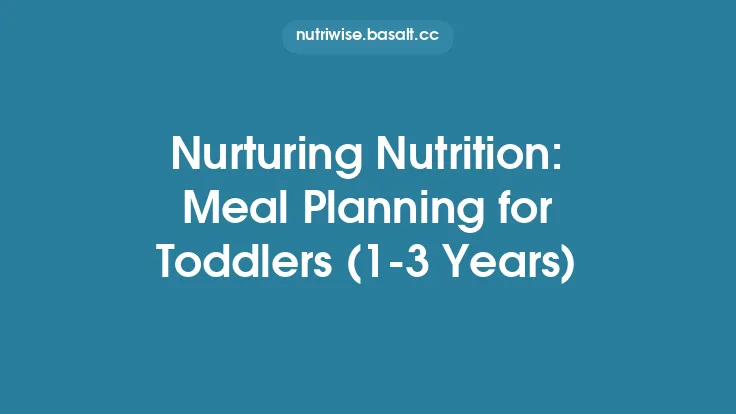Children between the ages of four and twelve are in a dynamic phase of growth, learning, and increasing independence. Their bodies demand a steady supply of energy and nutrients to support rapid skeletal development, expanding muscle mass, and the cognitive leaps that accompany school‑age learning. At the same time, they are beginning to make more of their own food choices, which can introduce both opportunities for healthy habits and challenges such as picky eating or reliance on convenience foods. A well‑structured, age‑appropriate meal plan provides the scaffolding needed to meet these physiological demands while fostering a positive relationship with food that can last a lifetime.
Understanding the Core Nutritional Requirements
Energy Needs Across the Age Spectrum
- 4‑6 years: Approximately 1,200–1,400 kcal/day, depending on activity level.
- 7‑9 years: Roughly 1,400–1,600 kcal/day.
- 10‑12 years: 1,600–2,200 kcal/day, with a noticeable increase for boys as they approach puberty.
These ranges are averages; individual needs vary based on sex, basal metabolic rate, and daily activity (e.g., sports, active play, sedentary screen time). Energy should be distributed across three main meals and two to three snacks to maintain steady glucose levels and prevent overeating at any single occasion.
Macronutrient Distribution
| Nutrient | Recommended Percentage of Total Calories | Practical Food Sources |
|---|---|---|
| Carbohydrates | 45‑65 % | Whole grains, fruits, starchy vegetables, legumes |
| Protein | 10‑20 % | Lean meats, poultry, fish, eggs, dairy, beans, tofu |
| Fat | 25‑35 % | Unsaturated oils, nuts, seeds, avocado, fatty fish |
A balanced macronutrient profile supports growth (protein), brain function (glucose from carbs), and hormone production and cell membrane integrity (healthy fats).
Micronutrient Essentials
- Calcium (1,000 mg/day) – critical for bone mineralization; sources include milk, fortified plant milks, yogurt, cheese, and leafy greens.
- Vitamin D (600 IU/day) – enhances calcium absorption; fortified dairy, fatty fish, and safe sun exposure are key.
- Iron (7‑10 mg/day) – supports hemoglobin synthesis; found in lean red meat, poultry, beans, fortified cereals, and spinach (paired with vitamin C for better absorption).
- Zinc (5‑8 mg/day) – important for immune function and growth; present in meat, dairy, nuts, and whole grains.
- B‑vitamins (especially B12 and folate) – essential for energy metabolism and neural development; abundant in animal products, fortified cereals, and legumes.
- Vitamin C (25‑45 mg/day) – aids iron absorption and collagen formation; citrus fruits, berries, peppers, and tomatoes are excellent sources.
Portion Sizes and Energy Density
Children’s stomachs are smaller than adults’, yet their nutrient needs are proportionally higher. Using the “hand” method can simplify portion control:
- Protein: A palm‑sized portion (≈ 30‑40 g cooked meat or fish, ½ cup beans).
- Starch/Grains: A cupped hand (≈ ½ cup cooked rice, pasta, or quinoa).
- Vegetables: Two fists (≈ 1 cup raw or cooked).
- Fruit: One fist (≈ ½ cup sliced fruit or a medium whole fruit).
- Dairy: A thumb‑sized portion of cheese or a cup of milk/yogurt.
Energy‑dense foods (e.g., nuts, seeds, avocado) should be included in modest amounts to avoid excess calories while still delivering healthy fats and micronutrients.
Building a Weekly Meal Framework
- Plan Around Core Food Groups – Ensure each day includes at least one serving from each group: protein, whole grain, fruit, vegetable, and dairy (or fortified alternative).
- Rotate Protein Sources – Alternate between animal and plant proteins to diversify amino acid profiles and micronutrient intake.
- Incorporate Colorful Vegetables – Aim for at least three different colors per day to maximize phytonutrient variety.
- Schedule Snacks Strategically – Pair a carbohydrate with a protein (e.g., apple slices with peanut butter) to sustain satiety and stabilize blood sugar.
- Design “Theme Nights” – Mexican, Mediterranean, or Asian-inspired meals can introduce new flavors while meeting nutritional goals.
A sample weekly template might look like:
| Day | Breakfast | Lunch | Dinner | Snacks |
|---|---|---|---|---|
| Mon | Oatmeal with berries & milk | Turkey & cheese wrap, carrot sticks, grapes | Baked salmon, quinoa, steamed broccoli | Yogurt + honey; whole‑grain crackers |
| Tue | Whole‑grain toast, scrambled eggs, orange slices | Chickpea salad, whole‑grain pita, apple | Chicken stir‑fry with brown rice, mixed veggies | Cheese stick; banana |
| … | … | … | … | … |
Age‑Specific Sample Meal Plans
Ages 4‑7 (Early School Years)
- Breakfast: Whole‑grain mini pancakes topped with a thin spread of almond butter and sliced banana; a glass of fortified soy milk.
- Mid‑Morning Snack: Small cup of cottage cheese with pineapple chunks.
- Lunch: Mini whole‑wheat quesadilla with shredded chicken, mild cheddar, and finely diced bell peppers; side of cucumber sticks; a small orange.
- Afternoon Snack: Handful of raisins and a few whole‑grain crackers.
- Dinner: Soft‑cooked lentil soup, a side of brown rice, and steamed carrots; a dollop of plain yogurt for dipping.
Ages 8‑12 (Pre‑Adolescence)
- Breakfast: Greek yogurt parfait layered with granola, mixed berries, and a drizzle of honey; a boiled egg on the side.
- Mid‑Morning Snack: Apple slices with a tablespoon of peanut butter.
- Lunch: Grilled chicken Caesar salad (light dressing) with romaine, whole‑grain croutons, and Parmesan; whole‑grain roll; a kiwi.
- Afternoon Snack: Trail mix (unsalted nuts, dried fruit, whole‑grain cereal).
- Dinner: Turkey meatballs in marinara sauce over whole‑wheat spaghetti; side of sautéed spinach; a small piece of dark chocolate for dessert.
These plans can be adjusted for vegetarian or gluten‑free preferences by swapping protein sources (e.g., tempeh, lentils) and using gluten‑free grains (e.g., millet, buckwheat).
Snack Strategies That Support Growth
- Combine Protein & Fiber: Hummus with veggie sticks, cheese with whole‑grain crackers, or a hard‑boiled egg with a small fruit.
- Limit Added Sugars: Opt for natural sweetness from fruit, a drizzle of maple syrup, or a sprinkle of cinnamon rather than candy or sugary drinks.
- Mind Portion Sizes: Pre‑portion snacks in reusable containers to avoid mindless overeating.
Hydration: The Often‑Overlooked Pillar
Children should drink water throughout the day, aiming for about 1.0‑1.5 L (≈ 4‑6 cups) depending on activity and climate. Milk or fortified plant milks contribute to fluid intake and provide calcium and vitamin D. Limit sugary beverages (sodas, fruit drinks) to occasional treats, and avoid caffeine‑containing drinks.
Managing Picky Eating Without Compromise
- Offer Repeated Exposure: It can take 10‑15 exposures to a new food before acceptance.
- Use “Flavor Bridges”: Pair a disliked vegetable with a familiar favorite (e.g., broccoli mixed into cheesy pasta).
- Involve the Child: Let them choose between two healthy options, wash produce, or stir batter.
- Keep Meals Structured: Serve meals at regular times and limit grazing on high‑calorie snacks.
- Model Positive Eating: Parents eating a variety of foods encourages children to mimic those choices.
Food Safety and Allergy Considerations
- Cook Meats to Safe Temperatures: Poultry (≥ 165 °F/74 °C), ground meats (≥ 160 °F/71 °C).
- Avoid Cross‑Contamination: Use separate cutting boards for raw meat and fresh produce.
- Be Vigilant with Common Allergens: If a child has a known allergy (e.g., peanuts, tree nuts, dairy, gluten), substitute with safe alternatives and read labels carefully.
- Store Perishables Promptly: Refrigerate leftovers within two hours and consume within 24‑48 hours.
Involving Kids in Meal Preparation
- Age‑Appropriate Tasks:
- *4‑6 years:* Washing fruits, tearing lettuce, stirring batter with supervision.
- *7‑9 years:* Measuring dry ingredients, assembling sandwiches, using a child‑safe knife.
- *10‑12 years:* Simple cooking techniques (e.g., sautéing vegetables, baking muffins), reading recipes, planning a weekly menu.
Hands‑on involvement boosts confidence, improves willingness to try self‑made foods, and teaches basic nutrition concepts.
Adjusting for Varying Activity Levels
Active children (sports, dance, martial arts) may need additional 200‑400 kcal on training days. Increase portions of complex carbohydrates (whole grains, starchy vegetables) and lean proteins while maintaining overall nutrient balance. Hydration becomes even more critical; encourage water before, during, and after activity.
Monitoring Growth and Making Adjustments
- Regular Check‑Ups: Pediatric growth charts track height, weight, and BMI percentiles.
- Watch for Signs of Deficiency: Fatigue, frequent infections, hair loss, or delayed wound healing may indicate nutrient gaps.
- Adapt Meal Plans: If a child is under‑ or over‑weight relative to peers, adjust portion sizes and snack frequency, focusing on nutrient‑dense foods rather than calorie‑dense “empty” foods.
Common Pitfalls and Evidence‑Based Solutions
| Pitfall | Evidence‑Based Solution |
|---|---|
| Overreliance on processed “kid‑friendly” meals | Replace with homemade versions using whole‑grain flours, reduced sodium, and added vegetables. |
| Skipping breakfast due to rushed mornings | Prepare grab‑and‑go options (overnight oats, fruit‑filled muffins) the night before. |
| Excessive juice consumption | Limit 100 % fruit juice to ≤ 4 oz per day; prioritize whole fruit for fiber. |
| Ignoring iron absorption factors | Pair iron‑rich foods with vitamin C sources (e.g., strawberries with iron‑fortified cereal). |
| Unstructured snacking leading to excess calories | Set specific snack times and pre‑portion servings. |
Resources and Tools for Parents
- MyPlate for Kids (USDA): Visual guide to balanced plates.
- Nutrition Fact Labels: Teach children to read serving size, calories, and key nutrients.
- Meal‑Planning Apps: Many free apps allow you to input age, activity level, and dietary restrictions to generate grocery lists.
- Cookbooks: Look for titles focused on “family-friendly” or “kid‑approved” recipes that emphasize whole foods.
Cultivating Lifelong Healthy Eating Habits
The goal of an age‑appropriate meal plan is not merely to meet daily nutrient targets but to embed a mindset of nourishment, curiosity, and balance. By providing structured yet flexible meals, encouraging participation, and respecting children’s evolving tastes, parents and caregivers lay the groundwork for a generation that views food as fuel, comfort, and cultural expression.





